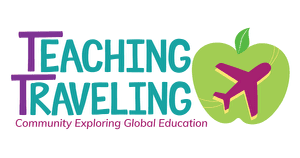Want to Publish as an Educator?
“Who am *I* to publish something?”
“There are better people out there to share their words than me.”
“It’s scary to make my ideas public!”
Have you or your students ever expressed these mental blocks to publishing writing for a wider audience? You’re not alone! Indeed, putting our words out there can seem terrifying, or even impossible — but on the other side of that mental block glistens a world of benefits. Let’s learn how to reach those gains and why, through examples from a real-world class.
Helping Students Publish their Work.
One of the most dramatic ways to add excitement and investment into an assignment for students is to offer the option of publishing it for a “real” (not just school) audience. Why is a wider audience so motivating?
Let’s face it: Sharing a piece of writing only with a teacher is a bit of a let-down (as cool as we educators are). Moreover, sharing work with one’s own class has the potential for social stress. However, getting a supportive comment from a peer across the city — or even country — is gold! Here’s a tale of how publishing worked with my Boston seventh graders which might help YOU think through ways it might be possible in your context.
This summer, I heard through the grapevine that the local nonprofit, Teens in Print, was open to adding in-school collaboration beyond their usual after school programming. (There may be similar organizations near you.)
I reached out to Teens in Print, and together we developed this photo essay assignment: a perfect opportunity for students to build community by sharing a topic important to them, all while honing their writing and photo skills.
I had Teens in Print staff members attend our classes to build excitement and share mentor texts of previously-published student photo essays from around Boston, then come to our Publication Celebration to read and comment on finished student photo essays (so great to get a wider range of adult feedback for each piece versus just me!) and encourage publication. This provided fresh motivation for doing another round of editing for spelling, grammar, and reader engagement. As one student exclaimed when she was finally published, “I’m famous!!!”
If you’re intrigued to try publishing with your students, here is a roadmap.
1. Investigate options.
Research what local websites, newspapers, magazines, and exhibits might be open to publishing student work. This may seem daunting, but soon you’ll see how many publications are hungry for fresh new words! Be bold and send off an email or introductory tweet.
2. Select the assignment carefully.
The paper or project you encourage students to publish shouldn’t be a classic one which is in danger of being used by other students to plagiarize (ex: a 5-paragraph essay on causes of the Civil War). Rather, publishing is best for unique pieces of writing or art which rely on the student’s identity as an individual.
3. Honor Privacy.
Keeping our students safe is our #1 priority, so it’s recommended to just use first names and last initials for minors, perhaps not even specifying schools. Permission slips can be easily sent out via Google Classroom or other electronic platforms to minimize paper paperwork shuffling.
Publishing as a Teacher
Now at this point, you may realize we have been going about this backwards. For us educators to encourage students to embrace the power of publishing, we must also at least once experience its joy, ourselves! Sharing our own experiences in publishing with students is a vital part of helping youth understand how real-world writing works, and why it’s so powerful. Why, even teaching grammar becomes easier when I can say, “I need to follow these editing rules, myself, because furious and confused readers write in whenever I mess them up!”
So now, some questions for YOU about publishing your OWN work:
- How many times has your work been published for a wider audience? (Ex: A magazine, newspaper, blog, book, etc. — no matter the size.)
- If you’ve published, how did it feel? Did anything come out of it?
- What has stopped you from publishing? Are you intrigued to try for more? If so, what are your hopes — or fears — around getting your ideas out there?
In my experience, what’s kept the majority of brilliant adults from publishing their words — words which could truly help others — is that these adults think there’s someone better than them to do so. WRONG!
Does this story sound familiar? Imagine there’s a teacher named Maria — a highly effective educator with over 17 years of experience — who is considering publishing an article that would illuminate a facet of school life which is rarely discussed, and could help many people. Maria works on the draft of this article for weeks, then gets frustrated that it isn’t perfect… and ultimately abandons it, muttering, “There’s probably someone better than me to publish.”
What happens next? Yes, someone else WILL publish, and it might be on a similar topic, but those authors likely didn’t teach for as long as Maria, nor have the depth of understanding as someone as experienced as Maria could provide. However, simply because they submitted, those other authors get the recognition — and readers lose out by getting a lower quality product. Maria WAS the better person to publish, but she just couldn’t believe it enough to try and find out.
The world needs to hear from YOU, what you have to say matters, and there are good publications which would be thrilled to publish your work today. I bet you $5 that if you send a pitch to five different outlets on a topic that lights you up, at least one will write back wanting to move forward. Most people never even try to pitch!
The Power of a “Minimum Viable Product”
What’s the other pitfall which destroys people’s publishing possibilities? Impossible pursuit of perfection. (I’ve seen countless articles die unseen because the author was obsessing about one word in the title.) Listen — nothing anyone writes is going to be perfect, so the key concept here is minimum viable product: a “good enough” try which is far from perfect, but is adequate enough to get out there. In other words, just push out a solid try which you know isn’t 100% so that you can get real-world feedback to edit for future iterations. Here’s an example.
In 2020 I launched a new website to feature my cartooning. I didn’t know which direction it would go in, but decided to just publish a minimum viable product and see where audience feedback led. I’m somewhat embarrassed to reveal that the first articles included such random gems as: person bouncing in an ice cream cone like a pogo stick, and cactus saying hello. The audience feedback was… confused. But at least I’d launched!

As the weeks went on, I began to tinker with articles and cartoons that actually made sense — and also learned a bunch of new digital art techniques along the way in order to pull off the effects I realized I needed. Now, the illustrated English lessons on DrawingsOf.com are getting readers from around the world who use the free articles in their ELA and ESL classes. Hooray! But I never would have come to that useful form of publication if I didn’t launch via the ridiculous minimum viable product of the ice cream cone pogo stick and gotten the feedback. The lesson for students and adults is clear: Just begin, because without putting your work out there and seeing authentic reactions, you can’t really see the path to progress!
One Thing Leads to Another
Here is the other secret about publication: opportunity begets opportunity. Though it’s always best to be paid for publication, I can’t tell you how many times I’ve accepted an unpaid gig — and it’s led to a chain of fabulous next opportunities. In fact, the reason I was able to give the talk this transcript is from is because in January, I agreed to provide a quote to a journalist for her article, which was read by a TV producer who contacted me to be featured in an on-air segment in February, which was seen by an OER staff member who then invited me to speak at their summer conference! Opportunity begets opportunity.
Obviously, do not run yourself ragged or ignore fiances — time, health, and money are precious — but DO consider taking the leap and getting your voice out there about something that matters to you, in a way that previously might have seemed out of reach.
Speaking of what’s in reach… one of the greatest gifts we can give to our students is to model for them what is possible. Have pride in your ideas and sing them far and wide, and then honestly discuss with your students about the journey and joys of publishing so they can learn from your real attempts. Our world needs to hear from your students and from YOU!
This speech originally appeared in video form in the 2021 OER Conference.

The author, Lillie Marshall, is a 6-foot-tall National Board Certified Teacher of English from Boston who has been a public school educator since 2003. She launched TeachingTraveling.com in 2010 to share expert global education resources, and over 1.6 million readers have visited over the past decade. Lillie also runs AroundTheWorld L.com Travel and Life Blog, and DrawingsOf.com for educational art. Do stay in touch via subscribing to her monthly newsletter, and following @WorldLillie on social media!
